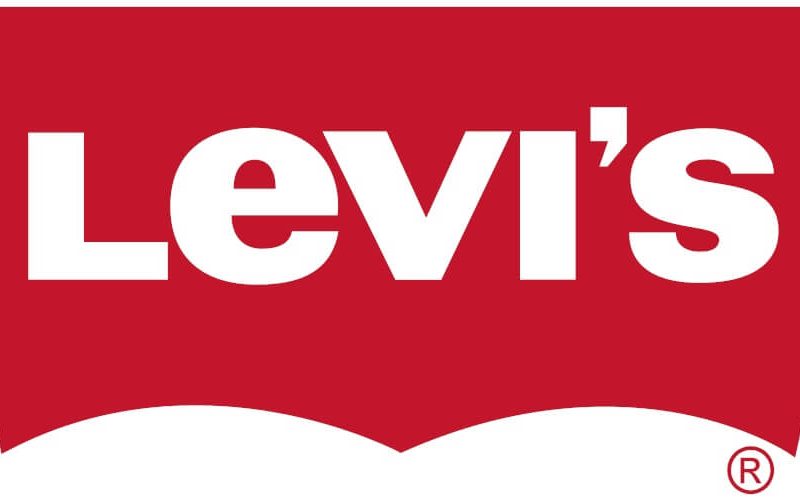Levi was launched in 1853, but it wasn’t until 20 years later that the company introduced the iconic blue jeans and a patented method of securing clothing with rivets. After a few years, the company’s first logo (the two-horse label) was created. A red tap logo is another emblem used by Levi’s. However, there are other variations of the Levi’s logo and a story behind the symbol we know today.
This article will walk you through the history, evolution, and meaning of the Levi logo.
What is the Levi Strauss & Co. Symbol?
The company’s symbol is Levi Strauss & Co’s iconic red batwing badge with bold white lettering. Aside from the geometric minimalistic banner, the company has another symbol. This Two Horse image was introduced in 1892 and can still be seen on the labels of the brand’s denim items.
The Evolution of the Levi’s Logo
For nearly 150 years, Levi’s has undergone approximately eight distinct redesigns. Some of these updated designs were mediocre, while others were admirable. Let’s take a quick look at its logo journey.
1853 – 1892: Maiden Wordmark
A wordmark logotype was used as the company’s first official logo. It’s a narrow rectangle with the owner’s name in all caps—Levi Strauss. The symbol & and Co. is also included in the logo. The numbers 16 and 14 are at the extremes. The symbol was monochrome in color.
1892 – 1925: Two-Horse Emblem
Levi’s began using a picture logo during this time period. It was famously known as “The Two Horse Brand.” The logo depicts two horses and their riders pulling jeans in opposite directions. The brand’s name appears above the horses and riders. Other inscriptions and the date it patents its rivet were also included. This logo was appealing to both literates and illiterates, as well as non-native English speakers. It was available in black and white.
1925 – 1929: Red Levi’s Logo
For four years, the clothing conglomerate used a new logotype. The company chose a simple wordmark that spelled out its name in large red letters. These typefaces were set against a light background with a black outline. Because the jeans had become well-known, it was an appropriate replacement for the photo logo.
1929 – 1943
The organization received its third update. It chose a thick white and blue modest wordmark signature this time. This logo is a shortened version of the owner’s name. It also had the tagline “America’s Finest Overall” in all caps. The letterings were placed on an orange rectangular frame by the designer.
1943 – 1949
The company’s logo was updated after 14 years. It chose a yellow frame with the owner’s first name on it. Uppercase, bold, and dark blue letters. The tagline was kept in caps—America’s Finest Overall in a light color.
1949 – 1954
The company redesigned its signature Levi logo in 1949. Levi’s, a red frame with a white uppercase, became the brand’s face. It was the time following World War II. Other inscriptions and design elements are included in the trademark.
1954 – 1969
The previous logo was improved: the red background became brighter and more solid. And its letters are now sharper and smoother. The phrase “Vintage Clothing” appeared beneath the brand’s name. It used a straightforward and readable sans-serif font. The letters in the logo were all in caps and white.
1969 – 2003
The stylized logo for the brand was created. Levi’s named it the Batwing because it resembles a spreading bat wing. This well-known logo consists of a bright red frame encircling the company’s name in white: Except for the letter e; the typefaces are all capital. The logo is modern, minimalist, and adaptable.
2003 – Present
For approximately 34 years, the bright batwing logo represented the brand. It was given a minor refreshment after such a long time. The designer chose a dark red background and reduced the typeface’s height. The contrast between the dark red and white letterings emphasized the logo’s appearance.
Red Tab symbol
The red button The Levi’s logo was first used in 1936, eight years after the brand’s current name was adopted. Because of its resemblance to the wings of a bat, this emblem is sometimes referred to as the batwing logo.
The 2011 Emblem
Turner Duckworth designers created the 2011 update to the Levi’s logo. A “cropped” trademark symbol is one of the design’s most intriguing elements. It has been a part of the company’s logo for many years.
Levi Strauss chose a straightforward brand for his family business: Levi’s. The first logo was more of a full-fledged illustration, with two horses looking in opposite directions and tied to jeans, and two people whipping horses to tear off the jeans tied to them. The later logo, which was placed on the back of the pants and was made of technical fabric, highlighted the shape of the owner’s buttocks.
Although it first appeared for practical reasons (there was insufficient space on the small tag for the entire registration mark), Levi’s top management and the designers they commissioned eventually decided to make the “folded” “R” the brand’s signature. Because of this and the consistent use of the recognizable batwing shape, the Levi’s logo is instantly recognizable without the need for the company’s wordmark.
Elements of the Levi’s Logo Design
The current color of Levi’s has three graphic elements: two colors and a typeface. However, this was not the case with the majority of its logo designs. Its first logo had many features that violate today’s branding guidelines. Nonetheless, it contributed to the brand’s success. The vital graphic elements Levi’s used in its logo designs are detailed below.
The Levi’s Symbol and Shape
A Rectangle:
Rectangles can be found in the majority of Levi’s logo designs. It’s also one of the most commonly used shapes in branding. A rectangle conveys stability, security, and assurance. The frame was used as a background aid for Levi’s logo designs, and it enhances the design elements in it.
What do two horses stand for on the Levi Logo?
A horse represents freedom, mobility, and power. It is also associated with self-assurance, nobleness, and endurance. Levi’s used two horses to pull a pair of jeans in opposite directions. The message is straightforward: we manufacture and sell high-quality, long-lasting jeans. Wearing jeans also allows us to move quickly and efficiently.
The Bat Wing:
Levi’s iconic logo is shaped like the spread of a batwing. The Batman symbol inspired the name. The shape is similar to the Arc Stitching on the back pocket of the jeans.
Colors of the Levi’s Logo
Red:
Red is the dominant color in Levi’s logo. It corresponds to passion and energy. Red conveys intense vibes that compel us to act. Its positive emotions include self-assurance, love, and power. On the other hand, it conveys rage, vengeance, and danger.
White:
The color of innocence gracefully paints the brand’s name in the majority of its logos. It provides the other colors with the necessary balance of beauty and clarity. White symbolizes purity, cleanliness, and simplicity. It can also exude perfection, hope, and open-mindedness.
Blue:
Levi’s logos from 1929 and 1943 were the color of trust, emphasizing the brand’s charisma. Blue symbolizes peace, loyalty, and serenity. The color of water can also inspire calm, confidence, and stability.
Yellow:
Levi’s used a yellow background for its symbol from 1943 to 1949. Yellow is the color of happiness and optimism. It can also be used to convey creativity, warmth, and intelligence. The color yellow can elicit negative emotions. Warmth, deception, and egotism are examples.
Black:
Black is the color of darkness, and it conveys elegance, power, and leadership. It’s a commanding color that evokes mystery, strength, and prestige. Sadness, depression, and pessimism are some of its negative emotions. The horse brand, Levi’s second logo, featured black graphic elements on a white background.
The Levi’s Logo Font
Levi’s is a fan of sans-serif fonts, having used various versions in its early designs. We can connect the current custom sans-serif font to Albert Jan Pool’s URW Linear Wide Ultra Bold.
Who Founded Levi’s?
Levi Strauss (Levi’s Founding Father):
Mr. Hirsch Strauss and Mrs. Rebecca Strauss welcome Levi Strauss on February 26th, 1829. He was born in the German state of Bavaria. His family was devoutly Jewish. Levi had six siblings, one from his mother and the rest from his father’s first marriage.
Being Jewish in Bavaria was difficult for Levi’s family. They faced a lot of religious prejudice. His father died of tuberculosis when he was sixteen years old. They immigrated to the United States with his mother and two sisters. He was around eighteen years old.
His two elder brothers, Jonathan and Louis, who ran a dry goods business in New York City, joined the family. When he first arrived, he worked for his brothers. J. Strauss Brother & Co. was their company name. Levi mastered the trade and, at one point, began selling it in Kentucky.
Levi became an American citizen in July 1853. During the same time period, he traveled to San Francisco to sell to mining workers. Levi founded his company while serving as the West Coast agent for his brothers. He gave it the name Levi Strauss & Co.
He collaborated with Jacob Davis, and the two had an impact on the clothing industry. Levi made a contribution to religious, social, and educational development. On September 26, 1902, he died at the age of 73. Jacob, Sigmund, Louis, and Abraham Stern, his nephews, took over the business.
Jacob W. Davis:
Jacob Youphes is a professional tailor who was born in Riga, Latvia. Later on, he changed his name to Jacob Davis. Jacob also had Jewish ancestors. He arrived in the United States at 23, settling in New York City. He began his tailoring business here.
Jacob lived in Maine, San Francisco, and finally, Weaverville. He moved to Canada from California in 1858. This is where he met his wife, Annie Parker, a German immigrant. After nine years in Canada, he relocated his family to San Francisco, California.
Jacob Davis and his family relocated to Virginia City, Nevada. He sold pork and tobacco before resuming his tailoring business. Jacob worked as a tailor, making tents, wagon covers, and horse blankets for railway workers. He purchased his fabric from Levi Strauss, who later became his business partner.
Jacob used thick cotton duck cloth and cotton denim to make his products. To protect the stitches, he used copper rivets. He invented the pant with copper rivets, and he and Levi Strauss applied for a patent on it in 1872. They obtained the patent on May 20, 1873.
Jacob W. Davis died in San Francisco in 1908 at the age of 77. He and his wife, Annie Davis, had six children. To honor him, authorities planted a plague near his tailor shop in Reno, Nevada, in 2006.
How Did Levi’s Start?
The collaboration between Levi Strauss and Jacob Davis popularized the Levi’s brand. Levi, a clothing vendor, previously sold fabrics, beddings, combs, handkerchiefs, and purses. Jacob, on the other hand, was a skilled seamstress with innovative ideas.
The two business owners had a friendly supplier-customer relationship. Levi Strauss & Co. founder Levi supplied Jacob with fabrics for his business. According to legend, in December 1870, a customer asked Jacob to sew working pants for her woodcutter husband.
Jacob used duck cloth and copper rivets to protect the garment’s seams and pockets when making these tough pants for the woman’s husband. The woodcutter’s strenuous working conditions were met by these novelty pants. As a result, word quickly spread among the railway workers.
Jacob made his creation in 1871 using denim fabric. To protect his invention, he sought financial assistance from Levi Strauss. As a result, on May 20, 1873, both entrepreneurs applied for and were granted a patent for “Improving Fastening Pocket Opening.”
Jacob relocated his family to San Francisco as a result of this new agreement and outrageous demands for the pants. He managed a manufacturing plant for Levi Strauss & Co. in the city.
What Is the Size of Levi’s?
Levi Strauss & Co. is an American clothing company best known for its Levi’s jeans. On May 1, 1853, Levi Strauss founded the company. It began by wholesaleing fabrics and other related products before expanding into the production of jeans.
Levi’s, Dockers, Signature, and Denizen are among its current brands. Globally, the company operates approximately 2,800 stores and employs approximately 17,000 people. The company generated approximately $5.6 billion in revenue and earned $283.21 in net income. These are figures from the fiscal year 2018.
Although the company is headquartered in San Francisco, it has a presence in nearly 110 countries. It was the second most trusted brand, but the most popular clothing brand in the world.
Conclusion
The competitive business environment leaves little room for complacency or mistakes. So, the fact that Levi Strauss & Co. has survived for nearly 168 years demonstrates that the brand continues to benefit new generations of customers. The brand’s success can be attributed to its ongoing innovation, high quality, and long-lasting products. Prices and extensive marketing campaigns are also important factors. Finally, the red and white batwing Levi logo has served as an effective spokesperson for the company’s success stories.
Related Articles
- RAIDERS LOGO: Why is the Raiders Logo a Pirate? (All You Need)
- BUSINESS CASUAL FOR WOMEN: Best Outfit Ideas 2023
- CASUAL OFFICE ATTIRE: Top Unique Attire for Both Men & Women in 2023
- MOST EXPENSIVE WATCH BRANDS: List of Most Expensive Watch Brands in the World






